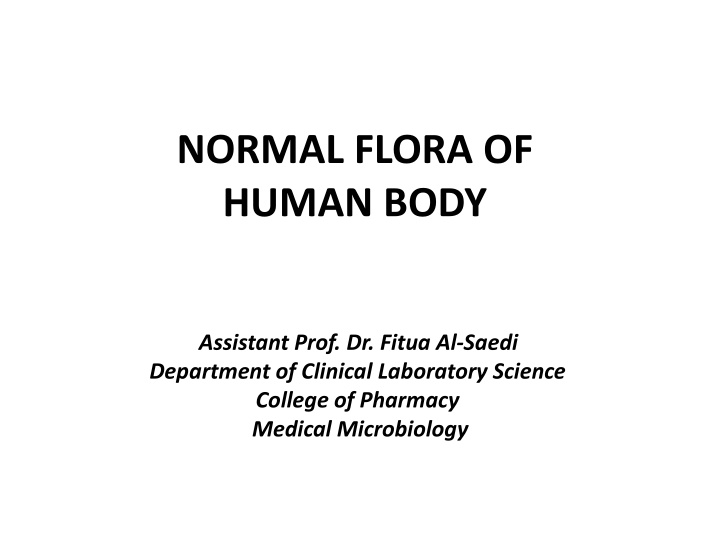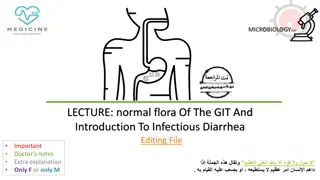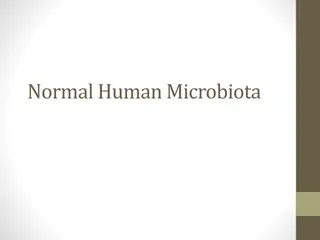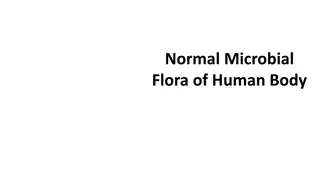Normal Flora of Human Body
Normal flora, comprising bacteria and fungi, are beneficial residents of specific body sites like the skin, colon, and vagina. These organisms, known as commensals, play a vital role in maintaining a healthy microbial balance. The internal organs are usually sterile, while different types of normal flora can be categorized as resident or transient. Carriers and colonization are also important concepts related to the interaction of microorganisms with the human body.
Download Presentation

Please find below an Image/Link to download the presentation.
The content on the website is provided AS IS for your information and personal use only. It may not be sold, licensed, or shared on other websites without obtaining consent from the author.If you encounter any issues during the download, it is possible that the publisher has removed the file from their server.
You are allowed to download the files provided on this website for personal or commercial use, subject to the condition that they are used lawfully. All files are the property of their respective owners.
The content on the website is provided AS IS for your information and personal use only. It may not be sold, licensed, or shared on other websites without obtaining consent from the author.
E N D
Presentation Transcript
NORMAL FLORA OF HUMAN BODY Assistant Prof. Dr. Fitua Al-Saedi Department of Clinical Laboratory Science College of Pharmacy Medical Microbiology
CONCEPT OF NORMAL FLORA Normal flora is the term used to describe the various bacteria and fungi that are permanent residents of certain body sites, especially the skin, oropharynx, colon, and vagina . Viruses and parasites (protozoa and helminths), which are the other major groups of microorganisms, are usually not considered members of the normal flora, although they can be present in asymptomatic individuals. The normal flora organisms are often referred to as commensals. Commensals are organisms that derive benefit from another host but do not damage that host.
The members of the normal flora vary in both number and kind from one site to another. Although the normal flora extensively populates many areas of the body, the internal organs usually are sterile. Areas such as the central nervous system, blood, lower bronchi and alveoli, liver, spleen, kidneys, and bladder are free of all but the occasional transient organism.
Normal Bacterial Flora can be arranged into two groups: 1.Resident Normal Flora consists of relatively fixed types of bacteria regularly found in a given area at a given age. It is acquired rapidly during & after birth and always present(permanent), if disturbed, it quickly reestablishes itself. 2.Transient Normal Flora It consists of both non-pathogenic and potentially pathogenic bacteria that inhabit the body surface or mucous membranes for a limited period. They can be removed from the body surface by mechanical means like Pneumococcus and Meningococcus can be removed from nasopharynx of the human beings from time to time.
Carrier The term carrier implies that an individual harbors a potential pathogen and therefore can be a source of infection of others. It is most frequently used in reference to a person with an asymptomatic infection or to someone who has recovered from a disease but continues to carry the organism and may shed it for a long period.
Colonization the term colonization typically refers to the acquisition of a new organism. After the new organism colonizes (i.e., attaches and grows, usually on a mucosal membrane), it may cause an infectious disease, or it may be eliminated by our host defenses. Furthermore, the person colonized by a new organism can transmit that organism to others (i.e., act as a reservoir of infection for others).
Advantages The presence of NormL Flora is not essential to life, yet, the resident flora of certain areas plays a definite role in maintaining health and normal function. For examples: First: Members of the resident normal flora in the intestinal tract synthesize vitamin K & B complex and aid in the absorption of nutrients and Food metabolism by producing proteolytic enzymes. Second: On mucous membranes and skin, the resident normal flora may prevent colonization by pathogens and possible disease through Bacterial Interference. The mechanism of bacterial interference may involve: 1. Competition for receptors or binding sites on host cells, 2. competition for nutrients, 3. mutual inhibition by antibiotic materials or bacteriocins (An antibacterial substance produced by a strain of bacteria and harmful to another strain within the same family). Third: The normal flora induces the Antibodies production. These Antibodies cross react with pathogens having related or shared antigens, thus raising the immune status of the host against the invading pathogen.
Disadvantages (i) They become pathogenic when the immunity is weak (immunocompromised patients) (ii) They may act as pathogens in different tissue (other than their normal habitat) e.g. normal flora of intestine may cause urinary tract infection (UTI).
Tissue specificity Most members of the normal bacterial flora prefer to colonize certain tissues and not others. This "tissue specificity" is usually due to properties of both the host and the bacterium. 1. Tissue tropism: One explanation for tissue tropism is that the host provides essential nutrients and growth factors for the bacterium, in addition to suitable oxygen, pH, and temperature for growth. Figure. Lactobacillus acidophilus colonizes the vagina because glycogen is produced which provides the bacteria with a source of sugar that they ferment to lactic acid.
2. Specific adherence Most bacteria can colonize a specific tissue or site because they can adhere to that tissue or site in a specific manner that involves complementary chemical interactions between bacterial surface components (ligands or adhesins) and host cell molecular receptors. The bacterial are molecular parts of their capsules, fimbriae, or cell walls. The receptors on human cells or tissues are usually glycoprotein molecules located on the host cell or tissue surface. Figure 2. Specific adherence involves complementary chemical interactions between the host cell or tissue surface and the bacterial surface.
Normal flora of Skin Microorganisms present on the skin surface are S.epidermidis and Diphtheroids are the most common. Less common are Peptococcus, Strept.viridens, Enterococcus, Micrococcus, E.coli, Candida, etc. Normal flora of Oropharynx. The main members of the normal flora of the mouth and throat are the viridans streptococci
Normal Flora of Upper Respiratory Tract Within 12 hours of birth alpha hemolytic streptococci are found in upper respiratory tract and become the dominant organism of the oropharynx and remains so for the whole life. In the pharynx and trachea, similar flora is established. Smaller bronchi and alveoli are normally sterile.
Normal Flora of Nose and Nasopharynx The nasopharynx of the infant is sterile at birth but in 2-3 days time it acquires the flora carried by the mother and attendants. The flora of nose harbours Diptheroids Staphylococcus Streptococcus Haemophilus, and Moraxella lacunata
Normal flora of Gastrointestinal tract. In the stomach as pH is low, the stomach is sterile but as the pH increases in small intestine the number of bacteria increases progressively beyond the duodenum to the colon. The bacterial count is low in small intestine as compared to large intestine. The colon contains the largest number of normal flora and the most diverse species, including both anaerobic and facultative bacteria. There are both gram-positive and gram-negative rods and cocci. The members of the colonic normal flora are an important cause of disease outside of the colon. The two most important members of the colonic flora that cause disease are the anaerobe Bacteroides fragilis and the facultative Escherichia coli.
Normal Flora of the Genitourinary Tract. The vaginal flora of adult women consists primarily of Lactobacillus species (keeps the pH of the adult women vagina low ). Lactobacilli appear to prevent the growth of pathogens. About 15-20% of women childbearing age carry group B streptococci in the vagina,which is an important cause of sepsis & meningitis in the newborn & is acquired during passage through the birth canal. Urine in the bladder is sterile in the healthy person ,but during passage through the outermost portions of the urethra is often becomes contaminated with S. epidermidis ,coliform, diphtheroids ,& nonhemolytic streptococci .























